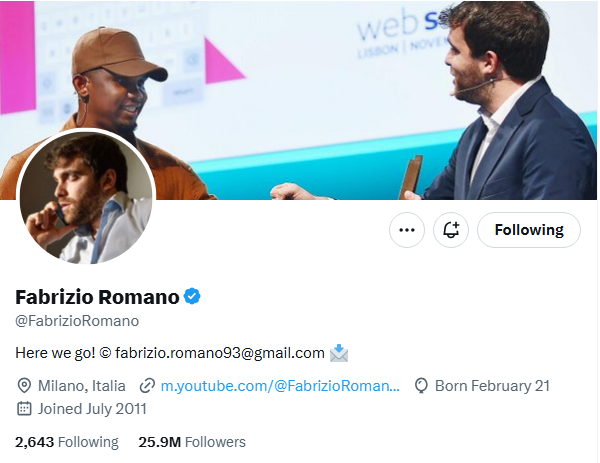For a generation of football fans, transfer windows once meant watching Sky Sports News until midnight, or scrambling for the morning paper’s gossip column. Today, it means waiting for a tweet from one man: Fabrizio Romano. The Italian journalist, once hailed as a beacon of reliability, has become a polarising figure, a symbol of football’s evolution into a 24/7 content machine, and for many, a symptom of its decay.
The Rise: How a Teenager from Naples Mastered the Transfer Market
Romano’s story began not in a newsroom but in his teenage bedroom. At 16, while his peers were focused on school, he was writing for FcInterNews.it, leveraging a chance connection with an agent in Barcelona to break news about Mauro Icardi. By 19, he was working with Sky Sport Italy, building the network of club officials, agents, and intermediaries by hanging around in spots they would frequent in Milan. His multilingualism (he speaks Italian, English, and Spanish) and work ethic allowed him to operate across Europe’s football landscapes, from Milan to Madrid.
What set Romano apart was his surgical precision. While traditional outlets speculated, he reported facts. His signature catchphrase, “Here we go!” became a digital seal of approval, a signal that a deal was done, not just rumored. For years, fans relied on him as a counterpoint to the noise of clickbait and conjecture. As The New York Times noted, he was “soccer’s prophet of the deal”.
The Mainstream Explosion: From Niche Insider to Social Media Giant
Romano’s shift from insider to influencer mirrored social media’s dominance over football culture. His subscriber count stands at 2.8 million on YouTube and over 25 million on X/Twitter and is a testament to his reach. Clubs began collaborating with him for player announcements; his voice was added to EAFC25; he won awards at the Globe Soccer Awards and Forbes’ 30 Under 30. He was no longer just a journalist, he was a brand.

But with scale came scrutiny. Romano’s business model, built on relentless tweeting and content aggregation, began to clash with fans’ expectations. In 2024, Danish outlet Tipsbladet revealed that his associated company had approached clubs offering paid mentions on his social media platforms. While Romano maintained editorial independence, the report eroded the myth of his neutrality.
The Backlash: When Reliability Became Repetition
For many fans, the frustration isn’t just about ethics, it’s about aesthetics. Romano’s timeline is a cluster of recycled updates, often repeating the same information hours apart with slight tweaks. A single transfer story might generate 10+ tweets, each optimized for engagement. An example of this is since June 1st of this year (until 22nd August), he has tweeted about the Garnacho transfer saga 40 times. Thats almost a tweet every other day, and he’s making a killing from it too. X pays creators for engagement. “Earnings are calculated based on verified engagements with your posts, such as likes and replies. The calculation considers the impact of different content types, such as articles, videos, spaces, and live broadcasts“. So there’s a reason he pumps out as many tweets as possible, and that was only about 1 player.
This model contrasts sharply with the nostalgia of pre-social media transfer culture. Older fans recall the thrill of waiting for the morning paper to confirm a signing or watching Sky Sports News’ yellow ticker on deadline day. My own personal memory of waking up to Berbatov signing for United and Robinho for City on deadline day in 2008 encapsulates this: deals felt like events, not content cycles. Today, the constant drip-feeding of information drains transactions of their magic.
The Irony: He Gave Fans What They Wanted
Romano’s downfall is rooted in a paradox: he perfected a system fans demanded but now resent. In an era of instant gratification, his real-time updates satisfied a hunger for certainty. Yet, this very accessibility has made transfers feel transactional and mundane. The “Here we go!” that once sparked delirium is now met with eyerolls, a symbol of the commodification of football’s most romantic period. Even other Journalists who are seemingly more respected than Romano, such as David Ornstien, have started to receive critism.
The Prophet at a Crossroads
Romano isn’t solely to blame; he’s a product of a ecosystem that rewards volume over nuance. But as football grapples with its soul, his trajectory mirrors broader tensions: between journalism and entertainment, between patience and immediacy, between tradition and progress. The very fans who propelled his rise are now mourning what’s been lost, not just a transfer window, but a ritual.


Leave a Reply